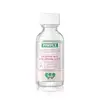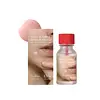What's inside
What's inside
 Key Ingredients
Key Ingredients

 Benefits
Benefits

 Concerns
Concerns

 Ingredients Side-by-side
Ingredients Side-by-side

Water
Skin ConditioningCalamine
AbsorbentGlycerin
HumectantNiacinamide
SmoothingButylene Glycol
HumectantSalicylic Acid
Masking1,2-Hexanediol
Skin ConditioningAmylopectin
Hydroxyacetophenone
AntioxidantDextrin
AbsorbentXanthan Gum
EmulsifyingZinc Oxide
Cosmetic ColorantAllantoin
Skin ConditioningSilica
AbrasivePEG-40 Hydrogenated Castor Oil
EmulsifyingDipotassium Glycyrrhizate
HumectantQuaternium-73
Lactobacillus/Soybean Ferment Extract
Skin ConditioningViscum Album Leaf Extract
SoothingImperata Cylindrica Root Extract
Skin ConditioningWater, Calamine, Glycerin, Niacinamide, Butylene Glycol, Salicylic Acid, 1,2-Hexanediol, Amylopectin, Hydroxyacetophenone, Dextrin, Xanthan Gum, Zinc Oxide, Allantoin, Silica, PEG-40 Hydrogenated Castor Oil, Dipotassium Glycyrrhizate, Quaternium-73, Lactobacillus/Soybean Ferment Extract, Viscum Album Leaf Extract, Imperata Cylindrica Root Extract
Water
Skin ConditioningAlcohol
AntimicrobialCalamine
AbsorbentGlycerin
HumectantTitanium Dioxide
Cosmetic ColorantButylene Glycol
HumectantSalicylic Acid
MaskingPanthenol
Skin ConditioningDimethyl Sulfone
SolventCeramide NP
Skin ConditioningGlycolic Acid
BufferingCentella Asiatica Extract
CleansingTartaric Acid
BufferingMalic Acid
Buffering1,2-Hexanediol
Skin ConditioningCamellia Sinensis Leaf Extract
AntimicrobialLactic Acid
BufferingChamaecyparis Obtusa Leaf Extract
Skin ConditioningUlmus Davidiana Root Extract
Skin ConditioningPueraria Lobata Root Extract
HumectantPinus Palustris Leaf Extract
TonicOenothera Biennis Flower Extract
AstringentWater, Alcohol, Calamine, Glycerin, Titanium Dioxide, Butylene Glycol, Salicylic Acid, Panthenol, Dimethyl Sulfone, Ceramide NP, Glycolic Acid, Centella Asiatica Extract, Tartaric Acid, Malic Acid, 1,2-Hexanediol, Camellia Sinensis Leaf Extract, Lactic Acid, Chamaecyparis Obtusa Leaf Extract, Ulmus Davidiana Root Extract, Pueraria Lobata Root Extract, Pinus Palustris Leaf Extract, Oenothera Biennis Flower Extract
Ingredients Explained
These ingredients are found in both products.
Ingredients higher up in an ingredient list are typically present in a larger amount.
1,2-Hexanediol is a synthetic liquid and another multi-functional powerhouse.
It is a:
- Humectant, drawing moisture into the skin
- Emollient, helping to soften skin
- Solvent, dispersing and stabilizing formulas
- Preservative booster, enhancing the antimicrobial activity of other preservatives
Butylene Glycol (or BG) is used within cosmetic products for a few different reasons:
Overall, Butylene Glycol is a safe and well-rounded ingredient that works well with other ingredients.
Though this ingredient works well with most skin types, some people with sensitive skin may experience a reaction such as allergic rashes, closed comedones, or itchiness.
Learn more about Butylene GlycolWe don't have a description for Calamine yet.
Glycerin is already naturally found in your skin. It helps moisturize and protect your skin.
A study from 2016 found glycerin to be more effective as a humectant than AHAs and hyaluronic acid.
As a humectant, it helps the skin stay hydrated by pulling moisture to your skin. The low molecular weight of glycerin allows it to pull moisture into the deeper layers of your skin.
Hydrated skin improves your skin barrier; Your skin barrier helps protect against irritants and bacteria.
Glycerin has also been found to have antimicrobial and antiviral properties. Due to these properties, glycerin is often used in wound and burn treatments.
In cosmetics, glycerin is usually derived from plants such as soybean or palm. However, it can also be sourced from animals, such as tallow or animal fat.
This ingredient is organic, colorless, odorless, and non-toxic.
Glycerin is the name for this ingredient in American English. British English uses Glycerol/Glycerine.
Learn more about GlycerinSalicylic Acid (also known as beta hydroxy acid or BHA) is a well-known ingredient for treating skin that struggles with acne and clogged pores. It exfoliates both the skin's surface and deep within the pores to help clear out buildup, control oil, and reduce inflammation.
Unlike AHAs (alpha hydroxy acids), salicylic acid is oil-soluble. This allows it to penetrate into pores which makes it especially effective for treating blackheads and preventing future breakouts.
Salicylic acid is also known for its soothing properties. It has a similar structure to aspirin and can calm inflamed or irritated skin, making it a good option for acne-prone skin that is also sensitive.
Concentrations of 0.5-2% are recognized by the U.S. FDA as an over-the-counter topical acne product.
It can cause irritation and/or dryness if one's skin already has a compromised moisture barrier, so it's best to focus on repairing that before introducing this ingredient into your routine.
While salicylic acid does not increase sun sensitivity, it’s still important to wear sunscreen daily to protect your skin.
If you are looking for the ingredient called BHA or Butylated Hydroxyanisole, click here.
Learn more about Salicylic AcidWater. It's the most common cosmetic ingredient of all. You'll usually see it at the top of ingredient lists, meaning that it makes up the largest part of the product.
So why is it so popular? Water most often acts as a solvent - this means that it helps dissolve other ingredients into the formulation.
You'll also recognize water as that liquid we all need to stay alive. If you see this, drink a glass of water. Stay hydrated!
Learn more about Water